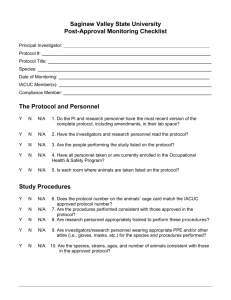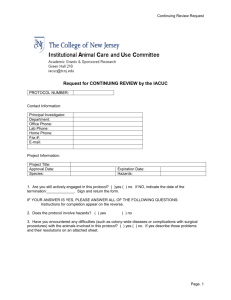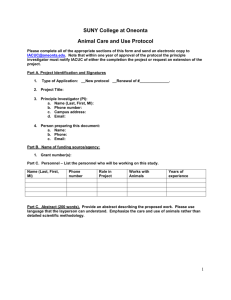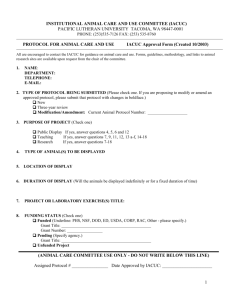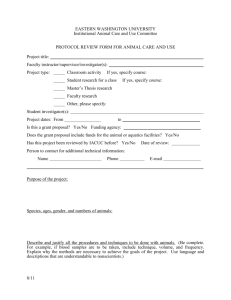Animal Use Protocol Section 1 - Basic
advertisement
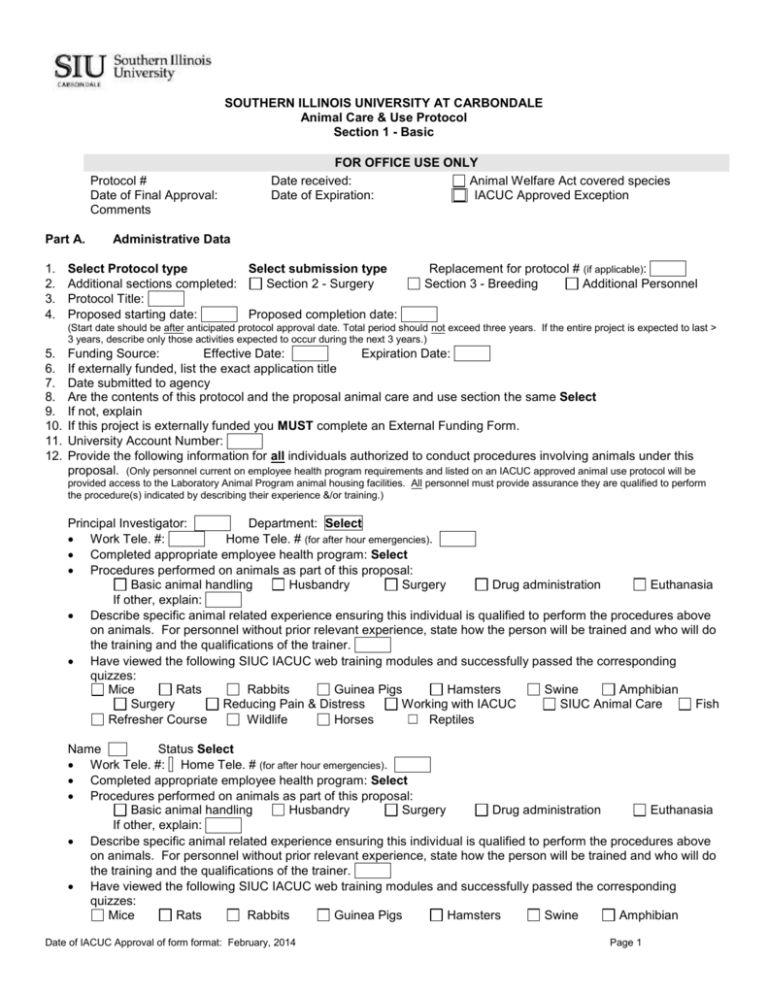
SOUTHERN ILLINOIS UNIVERSITY AT CARBONDALE Animal Care & Use Protocol Section 1 - Basic Protocol # Date of Final Approval: Comments Part A. 1. 2. 3. 4. FOR OFFICE USE ONLY Date received: Animal Welfare Act covered species Date of Expiration: IACUC Approved Exception Administrative Data Select Protocol type Select submission type Additional sections completed: Section 2 - Surgery Protocol Title: Proposed starting date: Proposed completion date: Replacement for protocol # (if applicable): Section 3 - Breeding Additional Personnel (Start date should be after anticipated protocol approval date. Total period should not exceed three years. If the entire project is expected to last > 3 years, describe only those activities expected to occur during the next 3 years.) 5. 6. 7. 8. 9. 10. 11. 12. Funding Source: Effective Date: Expiration Date: If externally funded, list the exact application title Date submitted to agency Are the contents of this protocol and the proposal animal care and use section the same Select If not, explain If this project is externally funded you MUST complete an External Funding Form. University Account Number: Provide the following information for all individuals authorized to conduct procedures involving animals under this proposal. (Only personnel current on employee health program requirements and listed on an IACUC approved animal use protocol will be provided access to the Laboratory Animal Program animal housing facilities. All personnel must provide assurance they are qualified to perform the procedure(s) indicated by describing their experience &/or training.) Principal Investigator: Department: Select Work Tele. #: Home Tele. # (for after hour emergencies). Completed appropriate employee health program: Select Procedures performed on animals as part of this proposal: Basic animal handling Husbandry Surgery Drug administration Euthanasia If other, explain: Describe specific animal related experience ensuring this individual is qualified to perform the procedures above on animals. For personnel without prior relevant experience, state how the person will be trained and who will do the training and the qualifications of the trainer. Have viewed the following SIUC IACUC web training modules and successfully passed the corresponding quizzes: Mice Rats Rabbits Guinea Pigs Hamsters Swine Amphibian Surgery Reducing Pain & Distress Working with IACUC SIUC Animal Care Fish Refresher Course Wildlife Horses ☐ Reptiles Name Status Select Work Tele. #: Home Tele. # (for after hour emergencies). Completed appropriate employee health program: Select Procedures performed on animals as part of this proposal: Basic animal handling Husbandry Surgery Drug administration Euthanasia If other, explain: Describe specific animal related experience ensuring this individual is qualified to perform the procedures above on animals. For personnel without prior relevant experience, state how the person will be trained and who will do the training and the qualifications of the trainer. Have viewed the following SIUC IACUC web training modules and successfully passed the corresponding quizzes: Mice Rats Rabbits Guinea Pigs Hamsters Swine Amphibian Date of IACUC Approval of form format: February, 2014 Page 1 Surgery Refresher Course Reducing Pain & Distress Wildlife Horses Working with IACUC ☐ Reptiles SIUC Animal Care Fish Name Status Select Work Tele. #: Home Tele. # (for after hour emergencies). Completed appropriate employee health program: Select Procedures performed on animals as part of this proposal: Basic animal handling Husbandry Surgery Drug administration Euthanasia If other, explain: Describe specific animal related experience ensuring this individual is qualified to perform the procedures above on animals. For personnel without prior relevant experience, state how the person will be trained and who will do the training and the qualifications of the trainer. Have viewed the following SIUC IACUC web training modules and successfully passed the corresponding quizzes: Mice Rats Rabbits Guinea Pigs Hamsters Swine Amphibian Surgery Reducing Pain & Distress Working with IACUC SIUC Animal Care Fish Refresher Course Wildlife Horses ☐ Reptiles Part B. Animal Data 1. Common animal name: Strain, Stock, Line or Breed: 2. Vendor or Source of animals: Select If other, describe: (Acceptance of all rodents and rabbits into the Laboratory 3. 4. 5. 6. 7. 8. Animal Program vivarium is contingent upon acceptable health surveillance information provided by the source institution to prevent inadvertent spread of infectious agents to other animals within the vivarium.) Maximum number of animals to be used for the duration of this proposal (i.e. total #/3 years): Pain or Distress Classification: (Indicate the number of animals used in each classification. If more than one classification applies to a single animal, the animal should be counted in the higher classification. Total of all classifications should equal that described in #3.) B: Animals being bred, conditioned, or held for use in teaching, testing, experiments, research, or surgery, but not yet used for such purposes. C: Animals upon which teaching, research, experiments, or tests will be conducted involving no pain, distress, or use of pain-relieving drugs. D: Animals upon which experiments, teaching, research, surgery, or tests will be conducted involving accompanying pain or distress to the animals and for which appropriate anesthetic, analgesic, or tranquilizing drugs will be used. E: Animals upon which teaching, experiments, research, surgery, or tests will be conducted involving accompanying pain or distress to the animals and for which the use of appropriate anesthetic, analgesic, or tranquilizing drugs will adversely affect the procedures, results, or interpretation of the teaching, research, experiments, surgery, or tests. Pain/Distress Classification B C D E If any animals are included in pain/distress classification E, provide scientific or regulatory justification for withholding pain/distress relief or state methods used to determine that pain and/or distress relief would interfere with test results. (Stating that pain relief may interfere with test results is not adequate.): I agree to track and have available upon request the number of animals in my possession, acquired or produced, or used as part of this proposal in each of the respective pain/distress classifications. Housing Site: Select If other, explain: List laboratory or other location(s), not including animal housing facilities, where activities involving living animals may occur. Building & Room number, or other description of location: What is the maximum amount of time the animals may be held there at one time? select Housing Type: Standard caging or pens Immunodeficient rodent housing requiring sterile caging, food and water supplies Rodent wire bottom cages (Housing rodents on wire bottomed cages must be justified), Justification: Aquaria Not applicable - animals are not housed. If other, describe: Describe any other special husbandry requirements (i.e. special caging, water, feed, waste disposal, etc.): Part C. Rationale for Animal Use and/or Establishing/Maintaining a Breeding Colony 1. Explain your rationale for animal use and the appropriateness of the species selected. (The rationale should include a justification of the species requested, the availability or appropriateness of the use of less-invasive procedures, other species, isolated organ preparations, cell or tissue cultures, or computer simulation. The species selected should be the lowest possible on the phylogenetic scale that is able to meet study goals. If breeding animals, the description should include how the colony contributes to the overall objectives of your research, why animals from commercial vendor sources are not appropriate, and if proposed solely to maintain a line for future use, include a discussion about why cryopreservation techniques are not appropriate.) Date of IACUC Approval of form format: February, 2014 Page 2 2. Justify the number of animals proposed for use. (The number of animals should be the minimum number required to obtain statistically valid results. Whenever possible, the number of animals should be justified statistically. If this is a request for breeding, the IACUC understands that you will not be able to give concrete statistical justification, however, you should be able to give an estimate of the number of animals you intend to breed and the reasoning behind that estimate.) Group size for experimental design requires this number for statistical significance. Other (Please describe): Part D. Study Objective Briefly explain in language understandable to a layperson the aim of the study and why the study is important to human or animal health, the advancement of knowledge, the good of society or educational/training benefits. (Do not give details of experimental procedures in this section.) Part E. Instruments and Supplies Complete the applicable sections below if any instruments and/or supplies are used to enter or are administered into areas of animals which are normally considered sterile (Examples include but are not limited to surgical instruments, supplies for administering drugs, experimental or therapeutic compounds. Infectious agents used as part of an experimental protocol are excluded from this part but should be described in Part I). Instruments & supplies are (check applicable boxes): clean but not sterile and will only be used for non-recovery procedures. acquired from commercial source(s) in a sterile form. autoclaved. passed through a 0.2 filter prior to being administered to animals. chemically sterilized. (To assure sterilization, it is recommended a product listed on the National Antimicrobial Information Network’s web page (http://www.fda.gov/cdrh/ode/germlab.html) be selected and used for the recommended length of time.) If using chemical sterilization methods, describe: Agent used: Contact time: Instruments &/or supplies will be rinsed with sterile prior to being used on animals. If other, describe: Part F. hours Methodology Describe all non-surgical activities involving living animals. Clearly indicate how many animals will be used in each test group, all applicable volumes and the sequence in which all procedures will be applied. The description should enable the IACUC to understand the experimental process beginning from the animal’s acquisition until the endpoint of the study. (Details of surgical procedures should be provided in Section 2 - Surgery.) Part G. General Information 1. If electrical shock will be used, complete the following. Select Strength: mA Duration: 2. If unanesthetized animals will be restrained by hand or mechanically, describe: Method of restraint: Duration of restraint: Frequency of restraint: Animal acclimation or training with respect to restraint device: Prolonged restraint justification (Applicable if > 30 minutes): 3. If food or water will be restricted for purposes other than in preparation for anesthesia, describe purpose, duration and frequency of restriction: 4. If the animals proposed for use have been used in previous experimental or teaching procedures, briefly describe previous activities: 5. If blood will be collected, describe: Route/Site of collection: Total number of collections per animal: Frequency of collection: Maximum volume collected per time point: Will anesthesia will be used during blood collection? Select. (Intracardiac and retro-orbital blood collection requires the animal to be anesthetized. Details of anesthesia use should be described in Part M.) 6. If biological samples other than blood will be taken from living animals, describe (sample type and freq. of collection): 7. If animal use proposal involves wild caught animals. Have all applicable permits been obtained? Select Have all investigators been informed about potential zoonoses involved in the capture and handling of these animals? Select Describe means of animal capture: Describe any potential for animal or human injury during capture and/or handling, methods used to minimize injuries, steps taken if injuries involving humans or animals do occur and personal protective equipment: Date of IACUC Approval of form format: February, 2014 Page 3 8. Animals will be immunized. (Description of usage should be included in methodology section, Part F. Freund's complete adjuvant should only be used once in an individual animal.) 9. 10. 11. 12. Name of adjuvant(s): If using Freund's Complete Adjuvant, describe why an alternative adjuvant cannot be used. Injection site: Number of sites: Volume of injection per site: Frequency of injection: Check box if controlled substances will be used as part of this protocol and the following are true. Controlled substances will be kept in a secure fashion in compliance with DEA standards. Only authorized personnel will be permitted access to controlled substance storage sites. Appropriate documentation relating to controlled substance usage will be maintained. Name of individual with Illinois Controlled Substance License and DEA registration: Check box if personnel other than Laboratory Animal Program staff will be providing husbandry care to the animals and the following are true. All animals will be observed daily (including weekends and holidays). Husbandry procedures will be documented. All personnel caring for the animals have been appropriately trained for the species maintained. Standard operating procedures are available for animal husbandry related procedures. All personnel caring for the animals have completed the appropriate occupational health requirements If fluid and/or electrolyte therapy is planned, describe: Fluid type: Route/Site administered: Volume administered: Frequency of administration: If planning to administer drugs or medications, complete the appropriate sections of the table below. (Details of analgesic, anesthetic and euthanasia agent administration should be described in Parts L, M, & N, respectively.) Generic Drug Name Dose (mg/kg) Route & Site Administered Frequency of Administration Needle Gauge (if applicable) 13. Describe transportation methods if living animals are to be transported as part of this proposal: 14. (Transportation methods must conform to all state and federal regulations. Description should include provisions for ensuring animals are protected from environmental extremes, whether food &/or water is provided during transit, approximate length of time in transit, a brief description of the animal enclosures, and the transport destination.) If animals will be subjected to periods of forced exercise (e.g. swimming, treadmills, etc.), describe: (Description should include methods proposed, whether the animals are preconditioned to the activity, length of time subjected to the exercise and frequency of exercise periods). Part H. Cell Lines and Biological Materials Complete the applicable sections below if inoculating cell lines or other biological materials into living animals. 1. Origin of material: human animal Cell line name(s) (if applicable): 2. If using human cell lines: Part I below MUST be completed. Is there an Occupational Exposure Control Plan established for you department or laboratory? Select Have all personnel involved in this research: received training for bloodborne pathogens within the last 12 months, and annually thereafter? Select received HBV vaccinations? Select Are there declination forms on file for those individuals not immunized against HBV? Select 3. If using animal cell lines, check the appropriate box(es) indicating the cell line(s) passage and testing history. Stock material is not of rodent origin and has not been previously passed in a rodent species at SIUC or any other institution. Stock material has been previously passed in a rodent species but has been tested following its final passage and found to be free of adventitious rodent disease agents. (Please attach a copy of the results) It is not known whether the stock material has been previously passed in a rodent species. MAP/RAP/HAP, or other testing to detect rodent pathogens will be performed and the results forwarded to the attending veterinarian before inoculating any rodent species with material from the cell line. Part I. Hazardous Agents Date of IACUC Approval of form format: February, 2014 Page 4 Complete the applicable sections below if living animals will be exposed to potentially hazardous agents. (See http://www.cehs.siu.edu/biological/ibc/ for more information about the Memorandum of Understanding and Agreement. Call the Radiation Safety Officer at 6-2015 for more information about the Application for Procurement and Use of Radioisotopes.) 1. Type of potentially hazardous agent (Check all that apply) Carcinogen Other Chemical Hazards (corrosive, flammable, reactive) Tumor Cell Lines Biohazards (Includes ALL infectious agents.) Recombinant DNA Radioisotopes (Only if administered to living animals.) 2. Description of agent(s)/material(s): (Required for any hazardous material/agent): 3. Describe procedures used to ensure safe handling, containment and disposal of contaminated animals and materials associated with this study: (Required for any hazardous material/agent): 4. Memorandum of Understanding Agreement (MUA) completed and submitted to Institutional Biosafety Committee (IBC)? Select 5. MUA approved by IBC? Yes; approval date No; pending 6. Application for Procurement and Use of Radioisotopes form completed and submitted? Yes; approval date No; pending 7. If husbandry personnel may potentially be exposed to the hazardous agent and/or toxic by-products through exposure to the animals or animal waste, describe recommended procedures for their protections, including information about signs and symptoms of overexposure. AGENT Part J. DOSAGE ROUTE Animal Endpoints 1. What is the experimental or teaching endpoint for the animals? (Check all that apply.) a. Animals will be humanely euthanized at a predetermined time following the start of protocol procedures. (Time of euthanasia should be described in Part F.) b. Animals will be humanely euthanized as part of the proposal but at a future undetermined time. Criteria for determining the time of euthanasia include: c. Animals will be returned to the colony or herd for reassignment to future or other projects. d. Animals captured from their natural habitat will be released back to their native environment or at a site comparable to the area from which they were captured. e. If animals will be permitted to live an undetermined length of time, will not be euthanized and will be allowed to expire naturally or due to protocol related procedures without other intervention, provide scientific justification (Justification should include why death as an endpoint must be used and why an earlier endpoint is not appropriate to meet study goals.) : f. Part K. If other, describe: Pain and Distress 1. If there are any potential adverse or negative effects the animal(s) may experience as a result of: the nature of the study procedures or surgeries performed (All survival surgical procedures potentially result in pain/distress and must be addressed.) compounds or agents administered (Note: Unless the contrary is established, procedures that cause pain or distress in human beings may cause pain or distress in other animals. Procedures with animals that may cause more than momentary or slight pain or distress should be performed with appropriate sedation, analgesia, or anesthesia, unless the procedure is justified for scientific reasons.) a. Describe the nature of the adverse or negative effects: b. Describe how the animals will be assessed, the frequency and length of monitoring (include provisions for after hour, weekend and holiday care if applicable): c. Describe criteria that will be used to determine when animals will be treated &/or euthanized, how the pain &/or distress will be alleviated, and clear directions concerning who can make the decision to euthanize &/or treat animals: 2. Describe the actions taken in the event of unexpected animal illness or injury: Part L. Analgesia Date of IACUC Approval of form format: February, 2014 Page 5 Complete the applicable sections below if providing analgesia (beyond that associated with the effects of anesthetic administration). 1. Analgesia will be administered: before the procedure during the procedure post-procedurally (Pre-operatively administration of analgesics or local anesthetics, referred to as "preemptive analgesia", has been suggested to delay the onset and severity of post-procedural pain. Preemptive analgesia's beneficial effects may not completely eliminate the need for post-operative analgesics but may minimize the dosage needed to maintain animal comfort.) Generic Drug Name Dose (mg/kg) Route & Site Administered Frequency of Administration (if applicable) Needle Gauge (if applicable) 2. Describe methods used if a non-pharmaceutical means of analgesia is proposed for use: 3. Justification for not providing analgesia (if applicable): (Animals undergoing survival surgical procedures should either receive analgesics or an explanation for not using analgesic agents should be given.) Part M. Anesthesia, Tranquilization and Sedation Complete the applicable sections below if administering tranquilizers, sedatives, anesthetics or paralytics. 1. Injectable Agents Generic Drug Dose (mg/kg) Route & Site Frequency of Needle Gauge (if applicable) Name Administered Administration (if applicable) 2. Inhalation Agents Agent: Select If Other, describe: Concentration of anesthetic gas to which animals will be exposed: Method of administration: Select If Other, describe: Method of scavenging waste gases: If using a fume hood, is it currently certified by CEHS? Select Other information (If applicable.): (Note: If planning to use ether, a justification for its use and a description detailing methods of safe handling and animal carcass disposal should be included. If planning to use a bell jar for anesthetic administration, the animals should be prevented from contacting liquid anesthetic-soaked materials. Compressed CO2 gas in cylinders is the only recommended source of carbon dioxide because the inflow to the chamber can be regulated precisely. Carbon dioxide generated by other methods such as from dry ice, fire extinguishers, or chemical means (i.e. antacids) is not recommended.) Describe methods used if a non-pharmaceutical means of anesthesia is proposed for use: 3. If paralytic agent(s) are planned for use, list agent(s), dosage, route/site of administration and how ventilation support will be provided. (Details of anesthetic usage should be included in 1 &/or 2 above.) Part N. Euthanasia If animals are to be euthanized, complete the applicable sections below. (Refer to the 2000 Report of the American Veterinary Medical Association Panel on Euthanasia available at http://www.avma.org/resources/euthanasia.pdf for recommendations.) 1. Physical method without anesthesia (Check all that apply) Decapitation Cervical dislocation Penetrating captive bolt Pithing If Other, describe method: PI ensures that all personnel potentially performing the above technique have been properly trained. Provide scientific justification for using the proposed methodology (If using a guillotine, also describe methods used to determine the blades are sufficiently sharp, and that the unit functions correctly and is able to be used in performing rapid and humane euthanasia.): 2. Physical method preceded by anesthesia Decapitation Cervical dislocation Exsanguination If Other, describe method: Other information (If applicable.): (If using a guillotine, describe methods used to determine the blades are sufficiently sharp, and that the unit functions correctly and is able to be used in performing rapid and humane euthanasia.) Anesthetic agent(s): (Details of anesthetic usage should be included in Part M.) 3. Chemical method Generic drug name: Other information (If applicable.): Dosage: Route/Site of administration: (Compressed CO2 gas in cylinders is the only recommended source of carbon dioxide because the inflow to the chamber can be regulated precisely. Carbon dioxide generated by other methods such as from dry ice, fire extinguishers, or chemical means (i.e. antacids) is not recommended. If using CO2 as a euthanasia agent, describe method used to confirm the animal is deceased prior to disposal (i.e. thoracotomy, cervical dislocation, etc.). Date of IACUC Approval of form format: February, 2014 Page 6 Part O. Assurance of Compliance 1. I have considered the following alternatives to the animal research, teaching or testing procedures described in the attached protocol and have determined that no potential alternatives consistent with the goals of the proposal are currently available. (Indicate the options considered.) Cell or Tissue Culture Computer Model Non-animal Procedures Less Invasive Procedures 2. I have considered the use of a phylogenetically lower species of animals and have determined that valid research results necessitate the use of the species indicated. 3. I certify the activities described in the attached protocol do not unnecessarily duplicate previous experiments. 4. If this protocol involves the use of a United States Department of Agriculture (USDA) regulated species, I certify that I have reviewed the pertinent scientific literature and the sources and/or databases and have found no valid alternative to any procedures described herein which may cause more than momentary pain or distress, whether it is relieved or not. Below are the methods used and sources consulted to determine the availability of alternatives, including refinements, reductions, and replacements. Names of databases searched: Period covered by search: Date the search was performed (i.e. 9/9/02): Keywords and/or search strategy: (Documentation for this section is required for all mammals used in biomedical research or teaching. Performance of a database search may be the most effective and efficient method for demonstrating compliance with the requirement to consider alternatives to painful/distressful procedures. However, in some circumstances (as in highly specialized fields of study), conferences, colloquia, subject expert consultants, or other sources may provide relevant and up-to-date information regarding alternatives in lieu of, or addition to, a database search. When other sources are the primary means of considering alternatives, sufficient documentation, such as the consultant’s name and qualifications and the date and the content of the consultation, should be provided to the IACUC as a separate attachment. Also the Animal Welfare Information Center (AWIC) is an information service of the National Agricultural Library specifically established to provide information about alternatives. AWIC can be contacted at (301) 504-6212, via E-mail at awic@nal.usda.gov or via its web site at http://www.nal.usda.gov/awic. If a database search or other source identifies a bona fide alternative method (one that could be used to accomplish the goals of the animal use proposal), the written narrative should justify why this alternative was not used.) 5. I have carefully considered the design of the study with respect to using the minimum number of animals necessary to ensure statistical validity and reliability of the obtained results. 6. I certify every effort has been made to minimize the amount of pain, distress and/or discomfort the animals may experience by providing anesthesia and/or analgesia whenever it does not interfere with proposal goals. Procedures involving animals will be carried out humanely and have been designed to ensure that discomfort and pain to animals will be limited to that which is scientifically unavoidable to meet study goals. 7. I agree that if an animal covered under this protocol becomes ill, is in pain or distress, and if the co-investigators or I cannot be reached, the attending veterinarian or designee may treat this animal including euthanasia for humane purposes. 8. I agree to comply with all federal, state, and university animal welfare laws and policies during this project and to cooperate with the SIUC Laboratory Animal Program in its supervision of these laws and policies. 9. I certify that I will obtain approval from the SIUC’s IACUC before initiating any significant changes in this study and will promptly notify the IACUC of any changes in personnel participating in the project. 10. I certify that all individuals authorized to conduct procedures involving animals under this proposal have been appropriately trained in the procedures in which they are involved. 11. I certify that all individuals authorized to conduct procedures involving animals under this proposal have met the necessary SIUC’s Occupational Health and Program requirements. Revised July 8, 2010 Principal Investigator (signature) _____________________________________ Date of IACUC Approval of form format: February, 2014 Date ______________________ Page 7


